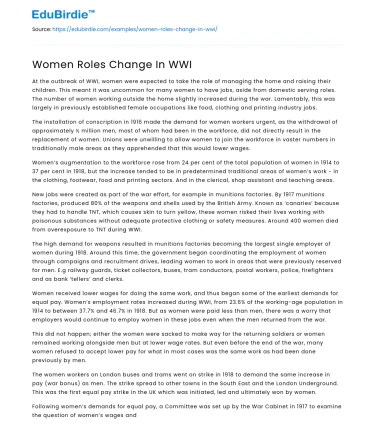At the outbreak of WWI, women were expected to take the role of managing the home and raising their children. This meant it was uncommon for many women to have jobs, aside from domestic serving roles. The number of women working outside the home slightly increased during the war. Lamentably, this was largely in previously established female occupations like food, clothing and printing industry jobs.
The installation of conscription in 1916 made the demand for women workers urgent, as the withdrawal of approximately ½ million men, most of whom had been in the workforce, did not directly result in the replacement of women. Unions were unwilling to allow women to join the workforce in vaster numbers in traditionally male areas as they apprehended that this would lower wages.
Save your time!
We can take care of your essay
- Proper editing and formatting
- Free revision, title page, and bibliography
- Flexible prices and money-back guarantee
Women’s augmentation to the workforce rose from 24 per cent of the total population of women in 1914 to 37 per cent in 1918, but the increase tended to be in predetermined traditional areas of women’s work - in the clothing, footwear, food and printing sectors. And in the clerical, shop assistant and teaching areas.
New jobs were created as part of the war effort, for example in munitions factories. By 1917 munitions factories, produced 80% of the weapons and shells used by the British Army. Known as ‘canaries’ because they had to handle TNT, which causes skin to turn yellow, these women risked their lives working with poisonous substances without adequate protective clothing or safety measures. Around 400 women died from overexposure to TNT during WWI.
The high demand for weapons resulted in munitions factories becoming the largest single employer of women during 1918. Around this time, the government began coordinating the employment of women through campaigns and recruitment drives, leading women to work in areas that were previously reserved for men. E.g railway guards, ticket collectors, buses, tram conductors, postal workers, police, firefighters and as bank ‘tellers’ and clerks.
Women received lower wages for doing the same work, and thus began some of the earliest demands for equal pay. Women’s employment rates increased during WWI, from 23.6% of the working-age population in 1914 to between 37.7% and 46.7% in 1918. But as women were paid less than men, there was a worry that employers would continue to employ women in these jobs even when the men returned from the war.
This did not happen; either the women were sacked to make way for the returning soldiers or women remained working alongside men but at lower wage rates. But even before the end of the war, many women refused to accept lower pay for what in most cases was the same work as had been done previously by men.
The women workers on London buses and trams went on strike in 1918 to demand the same increase in pay (war bonus) as men. The strike spread to other towns in the South East and the London Underground. This was the first equal pay strike in the UK which was initiated, led and ultimately won by women.
Following women’s demands for equal pay, a Committee was set up by the War Cabinet in 1917 to examine the question of women’s wages and released its final report after the war ended. This report endorsed the principle of 'equal pay for equal work'. But they expected that due to their ‘lesser strength and special health problems’, women's 'output' would not be equal to that of men.
Despite evidence that women had taken on what were considered men's jobs and performed them effectively during the war, this did not shift the popular (and government) perception that women would be less productive than men. The unions received guarantees that where women had fully replaced skilled men they would be paid the same as men. But it was made clear that these changes were for the duration of the war only and would be reversed when the war ended and the soldiers came back.






 Stuck on your essay?
Stuck on your essay?

